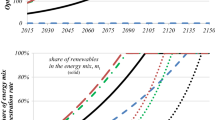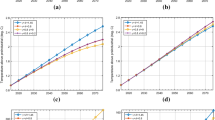Abstract
The paper investigates a climate-economy model with an iso-elastic welfare function in which one parameter γ measures relative risk-aversion and a distinct parameter ρ measures resistance to intertemporal substitution.We show both theoretically and numerically that climate policy responds differently to variations in the two parameters. In particular, we show that higher γ but lower ρ leads to increase emissions control. We also argue that climate-economy models based on intertemporal expected utility maximization, i.e. models where γ = ρ, may misinterpret the sensitivity of the climate policy to risk-aversion.
Similar content being viewed by others
References
Arrow, K.J. (1999), Discounting, Morality and Gaming, chapter 2. Washington, DC: Resources for the Future.
Barsky, R.B., F.T. Juster, M. Kimball and M.D. Shapiro (1997), 'Preferences Parameters and Behavioral Heterogeneity: An Experimental Approach in the Health and Retirement Study', Quarterly Journal of Economics, 537–579.
Epstein, L.G. and S.E. Zin (1991), 'Substitution, Risk-aversion and the Temporal Behavior of Consumption and Asset Returns: An Empirical Analysis', Journal of Political Economy 99, 263–286.
Gollier, C. (2002), 'Discounting an Uncertain Future', Journal of Public Economics 85, 149–166.
Ha-Duong, M., M.J. Grubb and J.-C. Hourcade (1997), 'Influence of Socioeconomic Inertia and Uncertainty on Optimal CO2-emission Abatement', Nature 390, 270–274.
Ha-Duong, M. and N. Treich (2000), Recursive intergenerational utility in global climate risk modeling. NOTA DI LAVORO 92.99, Fondazione Eni Enrico Mattei, 2000. Also presented at EMF/IEW meeting in Stanford, July 2000, at Journees de l'IDEI, Toulouse, 16–17 June 1999. Also presented at the EUREQUA, Paris Environmental Economics Seminar, 2 December 1999.
Hall, R.E. (1988), 'Intertemporal Substitution in Consumption', Journal of Political Economy 96, 338–357.
Kreps, D. and E. Porteus (1978), 'Temporal Resolution of Uncertainty and Dynamic Choice Theory', Econometrica 46, 185–200.
Nordhaus, W.D. (1994), Managing the Global Commons. Cambridge, Massachusetts: MIT Press.
Normandin, M. and P. Saint-Amour (1998), 'Substitution, Risk Aversion, Taste Shocks and Equity Premia', Journal of Applied Econometrics 13, 265–281.
Ogaki, M. and M.R. Reinhart (1998), 'Measuring Intertemporal Substitution: The Role of Durable Goods', Journal of Political Economy 106, 1078–1098.
Selden, L. (1978), 'A New Representation of Preferences over “Certain × Uncertain” Pairs: The “Ordinal Certainty Equivalent Hypothesis”', Econometrica 16, 1045, 1060.
Weitzman, M. (1998), 'Why the Far-distant Future Should be Discounted at its Lowest Possible Rate? Journal of Environmental Economics and Management 36, 210–208.
Working Group III IPCC (ed.) (2000), Summary for Policymakers of IPCC Special Report on Emissions Scenarios. UNEP-WMO.
Author information
Authors and Affiliations
Corresponding author
Rights and permissions
About this article
Cite this article
Ha-Duong, M., Treich, N. Risk Aversion, Intergenerational Equity and Climate Change. Environmental and Resource Economics 28, 195–207 (2004). https://doi.org/10.1023/B:EARE.0000029915.04325.25
Issue Date:
DOI: https://doi.org/10.1023/B:EARE.0000029915.04325.25




